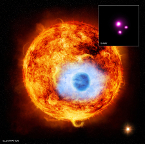 HEAPOW: Caught in Transit (2013 Aug 05)
HEAPOW: Caught in Transit (2013 Aug 05)
Planets around distant stars, or "Exoplanets", are extremely difficult to detect since planets are so much smaller and so much fainter than the stars around which they orbit. Planets can be detected by the tiny gravitational tug they impose upon their host stars as they revolve in orbit. Planets can also be identified by the small drop in starlight which happens when the planet passes in front of the star. Detecting these planetary transits requires ultra-high precision measurements. Observatories like NASA's Kepler and ESA's COROT spacecraft have found thousands of planetary candidates and dozens of confirmed planets by monitoring small changes in starlight. And now X-ray observatories are getting into the act. The graphic above depicts the star HD 189733A, and its planetary companion HD 189733Ab. In this picture, the inset shows the Chandra X-ray image of the HD 189733 system; HD 189733A is the brightest source, while a companion star HD 189733B is just below it to the right; the third source is a background object. HD 189733Ab was discovered in 2005, and is known as a "hot Jupiter" since it's about as massive, and as big, as the planet Jupiter, but much closer to its parent star. Unlike Jupiter, which orbits the Sun once every 4,332 days, HD 189733Ab only takes a bit more than 2 days to orbit HD 189733A. New data from the Chandra X-ray Observatory, along with archival data obtained by the XMM-Newton X-ray Observatory, have revealed for the first time a drop in X-ray light produced as HD 189733Ab passes in front of its star. Oddly enough, the drop in X-ray brightness is much larger than the drop in optical light, as if the planet is much bigger in X-rays (relative to the emitting region) than it is optically. Being so close to its host star, HD 189733Ab exists in a rather hostile radiation environment; the stellar X-ray and UV radiation blasting HD 189733 Ab is evaporating the planet's atmosphere. Maybe at some point enough of the planet's atmosphere will be stripped off to reveal what lies beneath.
CXC: HD 189733: NASA's Chandra Sees Eclipsing Planet in X-rays for First Time
viewtopic.php?t=31831
| << Previous HEAPOW | High Energy Astrophysics Picture of the Week | Next HEAPOW >> |
